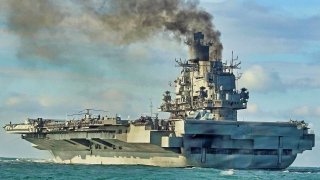Black Smoke: Russia's Admiral Kuznetsov Aircraft Carrier Has a Problem
Russia’s sole aircraft carrier, the Admiral Kuznetsov, is notorious for its numerous operational issues, including engine failures, costly repairs, deadly fires, and persistent black smoke emissions. Powered by Mazut, a heavy, tar-like bunker fuel, the Kuznetsov struggles with inefficient combustion due to low-quality piping and boiler systems.
What You Need to Know: Russia’s sole aircraft carrier, the Admiral Kuznetsov, is notorious for its numerous operational issues, including engine failures, costly repairs, deadly fires, and persistent black smoke emissions. Powered by Mazut, a heavy, tar-like bunker fuel, the Kuznetsov struggles with inefficient combustion due to low-quality piping and boiler systems.

-This leads to frequent boiler breakdowns, reducing the ship’s speed to a sluggish 4 knots and necessitating tugboat assistance, as seen in the 2012 incident near Syria. Despite these flaws, Russian officials downplay the problems, attributing the black smoke to maritime tradition.
-Unlike U.S. carriers, which use nuclear power, the Kuznetsov’s reliance on Mazut hampers its reliability and operational effectiveness.
Inside Russia’s Troubled Admiral Kuznetsov: The Smoky Aircraft Carrier
Russia’s lone aircraft carrier, the Admiral Kuznetsov, is internationally recognized for all the wrong reasons: engine failures, costly repairs, a deadly fire, and especially, a constantly spewing, putrid smoke.
Russia's Only Aircraft Carrier Is a Smoky Mess
Russia's Kuznetsov runs on a goopy, tar-like substance called Mazut. Sailors regard Mazut as a noxious, sticky nuisance–nearly impossible to remove from clothing.
A heavy petro-chemical, Mazut was the standard fuel for military and commercial vessels through the 1970s, mostly because the sludge’s thick viscosity gave it a high volume to energy ratio relative to lighter distillates. Yet, Mazut had numerous drawbacks, which is why most new ships were installed with nuclear or gas turbine propulsion systems.
Not the Kuznetsov, however, which the Soviet Union launched in 1985 – nearly two decades after the industry pivoted away from Mazut.
Today, the Kuznetsov serves as a belching reminder of why that pivot occurred.
Mazut would be considered a Bunker B or Bunker C fuel. Bunker fuels, which is a colloquial term for the fuel oil that marine vessels use, are divided into A, B, or C classifications, based on their boiling points, carbon-chain lengths, and viscosities.
A is the highest quality classification. C is the lowest. Lower quality fuel emissions, like Mazut’s, typically produce large amounts of sulfur and have negative effects on the environment and human health.
Burning Mazut is complicated. The fuel must be preheated and pressurized using an intricate system of boilers and pipes. So naturally, when using Mazut, properly functioning boilers and pipes are absolutely vital.

The Soviets, however, installed low-quality pipes in the Kuznetsov, setting the ship up for a service life of failure. With shoddy piping, the Kuznetsov is not able to operate all of its boilers at full capacity, all the time.
In fact, the boilers often break down, leaving the ship’s operators to alternate between the functioning boilers. Sometimes, the ship is reduced to using just one boiler, which allows for travel at a glacial 4 knots. Tugboats are often sent to accompany the underpowered and unreliable Kuznetsov.
Actually, in 2012, after returning from the coast of Syria, the Kuznetsov lost power entirely – likely due to boiler failure – and had to be dragged home behind the Russian tugboat Nikolay Chiker. Humiliatingly, the Kusnetsov required escort for 2,700 miles – a fact Russian tried to conceal from the world.
Another consequence of the Kuznetsov’s low-quality pipe and boiler system: black smoke.
The Kuznetsov’s black smoke is likely the result of improper calibration in the preheating or injection mechanisms. So, the Mazut injected into the combustion chamber may not have had time to combust fully. The result: only partially burned Mazut is being released into the atmosphere – in the form of black smoke.
Russia regularly downplays Kusnetsov’s smoking problem. Russian Admiral Ivan Vasilyev, for example, claimed the black smoke was deliberately created, in adherence to maritime tradition, to announce the Russian’s presence.
Why Make a Mazut Aircraft Carrier?
Why Russia created a Mazut-consuming aircraft carrier, in the 1980s, while nuclear and gas turbine options were available, is something of a mystery.
US aircraft carriers, constructed at the same time, relied exclusively on nuclear power. As a result, only crew endurance and supplies limit the US fleets ability to operate. There are no boiler issues, no black smoke, and certainly no tugboats involved.
About the Author
Harrison Kass is a prolific defense and national security writer who has over 1,000 articles published. An attorney, pilot, guitarist, and minor pro hockey player, he joined the US Air Force as a Pilot Trainee but was medically discharged. Harrison has degrees from Lake Forest College, the University of Oregon School of Law, and New York University’s Graduate School of Arts & Science. He lives in Oregon and regularly listens to Dokken.
Image Credit: Creative Commons.


